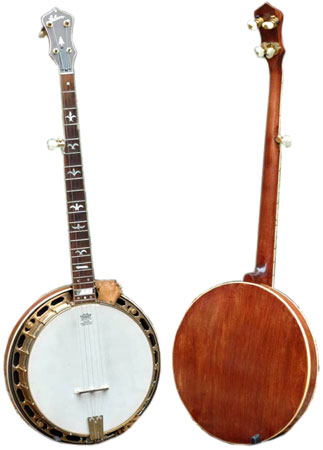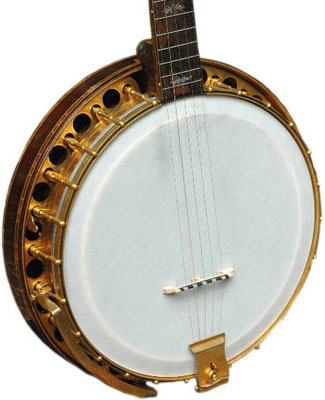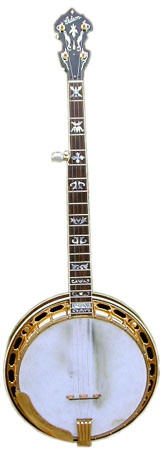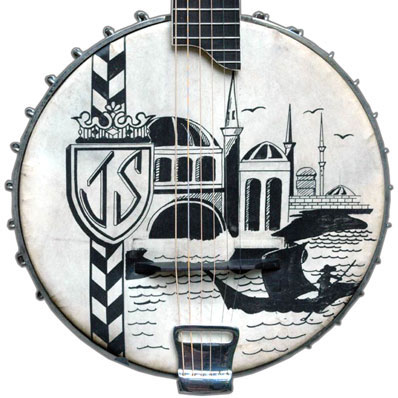With the passing of Earl Scruggs this past week, we thought it fitting to pass along this article we found over on Collector's Weekly about vintage Banjo's. Earl Scruggs is a foundation in the bluegrass community after his work with Bill Monroe and Lester Flatt paving the way for new forms of melody and picking. The article below gives much more incite into the history of the Banjo and goes into detail on the beauty of the instrument in the design compared to a variety of other pieces, enjoy.
By Maribeth Keane and Joyce Millman
Vintage banjo collector Lowell Levinger is perhaps best known to 1960s music fans as “Banana,” the bushy-haired guitarist and keyboards player for The Youngbloods. Today, Levinger is the proprietor of Players Vintage Instruments, where he buys and sells vintage guitars, mandolins, banjos, and other musical instruments. He also performs bluegrass and folk music for families under the name Grandpa Banana. Recently we spoke with Levinger about vintage banjos and the evolution of the instrument, from its African roots to its role as a bluegrass staple.
I bought my first really good bluegrass banjo in 1963 from a banjo player who lived in New York. His name was Winnie Winston, and he was a mentor of mine. It was a great banjo, a Gibson RB-1 Mastertone, and I played it for a few years. Then, in 1966, it was stolen out of my Lower East Side apartment. I looked in vain for it in pawnshops and all the old instrument shops. Finally, I gave up.
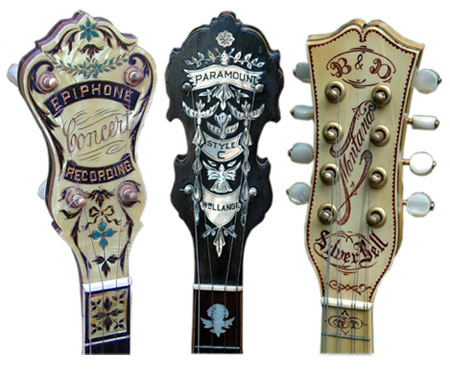
From left to right, headstocks (pegheads) for a 1928 Epiphone Concert Recording five-string, a 1929 Paramount Style C, and an eight-string B&D Silver Bell mandolin banjo from 1927.
Then, about four, five months ago, it showed up on online. I got in touch with the guy who was selling it, and of course he had no idea what the history of it was. He had just bought it from somebody a year ago. I told him my story, but put yourself in his place: it’s a hard story to accept, and I didn’t have any proof. I filed a police report back then, but the New York City Police Department had more important stuff to do.
I wasn’t absolutely positive from the pictures and descriptions that it was mine, but it sure looked like it. We went back and forth, and he offered to sell it to me for what he had in it, which was quite a bit of money. I bought it for 600 bucks back in 1963. I had so many banjos anyway that I didn’t really need another, especially if I wasn’t totally sure it was mine. So I said, “I don’t think I’ll do it,” and he said, “Well, I think I’ll just hang on to it rather than sell it.”
Then about a month ago, I was looking through a drawer and I found this little piece of paper. I’d written down the instruments I owned in 1964. And here was this banjo and here was the serial number. I checked back through my correspondence with the guy and, sure enough, it actually was my banjo. So I paid his price, and I now have my very first bluegrass banjo back, and it plays and sounds great. To me, it’s like an old part of me has been returned.
Collectors Weekly: How did you get into music?
Levinger: My mother was a pianist, so we had a piano in the house. As soon as I could touch the keys I started messing around, and I began taking piano lessons probably at about the age of five, or something. I didn’t pick up a guitar until I was probably 14 or 15 years old and I discovered, wow, that sounds great! But I never really took lessons or anything. I just learned to play. And then when I was in my senior year of high school, I heard Earl Scruggs for the first time, and it changed my life. I had to get a banjo and learn to play the banjo, and that’s just what I did.
My first guitar was a really cheap, horrible Stella with an action that was impossible to play. After that, I got a Gibson. It must’ve been one of those mahogany B-25s or B-15s. I hated it, but at least you could play it. I had a Gibson J-50 after that, which I also didn’t like very much. I never really got a good guitar until I went to college in Boston, where I met Rick Turner.
At that point, we were both beginning to realize that new guitars were not what you wanted. And so we started cruising the antiques stores and old-instrument shops of Boston. They mostly had violins but a few guitars and banjos, too. We also traveled to the little towns on the North Shore and the Cape and found some banjos and Martin guitars.
This was circa 1962. We knew that the Martins were really good and we knew that Vega banjos were really good and Gibson banjos were really good. We also learned about Lyon and Healy and Weymann. And all of them were better than buying a new Gibson, or something like that. Old instruments are better, because of the sound you can get out of them, especially if you’re willing to put a little work into it to get them set up really nicely. The sound is more focused, warmer, and has more character. It’s not jangly. They feel better and are more enjoyable to play.
I currently own maybe 15 or 20 banjos. I play them all every once in a while. For bluegrass I play my Gibson Mastertone. Well, for everything these days, I play my Gibson Mastertone. For gigs, I’m only playing the one that I just got back.
I’m also a big fan of Paramount banjos. Paramount made really nice banjos back in the late 1920s. William L. Lange was involved in a few early banjo companies and then went off on his own and formed Paramount banjos. He made banjos under a lot of other names, too. Orpheum was one of them, and Lange Style was another. And boy, did he put out a lot of banjos. He was in New York. He must’ve made thousands of banjos a year. He published these very nice catalogs that are pretty readily available.
In the early years of the Depression, 1930, ’31, Lange had Martin build some guitars for him. Everybody was having hard times, but I’m surprised Martin stooped to this. They had a very radical design. You can see a few of those on the Museum page of my website. They made some tenor guitars and some six-strings, and they have these crazy resonators with the holes in the top around the edges. They made about 30 or 35 of these very strange guitars. The Martin-Paramount connection, however brief, is fascinating.
But Lange’s banjos were some of the very best for the type of music that was popular at the time. They were the precursors to the B&D Dixieland banjos, which were probably the most popular for that style of playing. Lange’s workmanship, his intricacy of design, and the complexity of the inlay—he had a really great eye. But they also sound good.
William L. Lange. I’d love to know what the L stands for. I have a feeling it might be Leo because there are these guitars called Leo Masters that really have the William L. Lange look to them. There are a couple of them on my website. And I’ve never been able to get much history on them, but I have this suspicion that they might have been made by Regal for Lange. But I have nothing to back that up, no documentation.
Paramount banjos are generally not rare. They made gazillions of them, especially the tenors. They also made a lot of plectrums, which are four-string banjos that have a longer scale length than a tenor—they have 22 frets instead of 19 and they’re tuned a little bit differently. You can find Paramount tenor banjos on eBay every day, especially the lower-end models, the style As, and below that. You get up to the style Es and Fs, which were the more expensive ones, then they become more rare. And Paramount only made a very, very limited number of five-strings, so those are exceedingly rare.
Collectors Weekly: When did the banjo gain recognition as a country, folk, and bluegrass instrument?
Levinger: Earl Scruggs made the banjo a bluegrass instrument. When he and Lester Flatt joined Bill Monroe’s band in 1946, that was a key moment in bluegrass. In fact, a lot of people say that’s when bluegrass music was born. Earl Scruggs brought with him this style of picking that he had adapted through listening to Snuffy Jenkins and a few other people who were playing the three-finger style of the time. But he took that style and smoothed it out and made it more melodic, more complex, more interesting. He was a virtuoso by the time he and Flatt joined Bill Monroe’s band.
In the mid-1950s, Pete Seeger and the Weavers launched the banjo into prominence as a folk instrument. Seeger played a custom long-neck Vega with three extra frets, so he could tune it down lower. It suited his singing, gave him an interesting tone, and let him play in additional keys with the same fingering. Pete Seeger published a book, How to Play the 5-String Banjo, that was used by every kid who wanted to learn how to play the instrument from 1959 to 1979.
The five-string banjo is actually having a bit of a heyday right now. The Dixieland banjo’s heyday was in the late 1920s, 1925 to 1929. And then, prior to that, in the late 1800s, the five-string banjo had an earlier heyday, when people played this funny Vaudevillian banjo music. It was like banjo ragtime music—they played it in blackface, using five-string banjos (some of them used four-string banjos) and it was associated with comedy and slapstick.
If you look at the old Paramount catalogs from that period, you’ll see pictures of all these banjo players who were endorsing their products. It’s fascinating to try and think about what they were like and what they were playing and whatnot.
Four-string banjos are different. They are tuned in fifths like a mandolin, mandola, and mandocello. It’s very difficult to play bluegrass on a four-string banjo tuned in fifths. But you can play all kinds of other chord voicings and melody lines on a four-string more easily than you can a five-string banjo tuned to an open G chord. It’s just two completely different worlds. Six-string banjos are just tuned like a guitar. They are really for guitar players who want to have plunky tones but don’t want to learn to how to play a banjo.
Today the banjo is associated with Vaudeville and Dixieland and bluegrass, but it originally evolved in Africa. Slaves who were captured and forced onto ships brought the instrument with them. They made them out of gourds.
The banjo is very much like a drum. The rim is made of heated and bent wood—sometimes the wood is laminated—then wet animal skin is stretched over the rim and tapped on. When it dries it tightens and, bingo, you’ve got a drum. If you put a neck on it and some strings, you’ve got a banjo. So African Americans did that when they got over here. And then white guys caught on.
Collectors Weekly: How did the banjo evolve in the 20th century?
Levinger: As banjo-making became almost an industry in the late 1800s, all kinds of different woods were used—more expensive and fancier woods in the higher-end models, plainer woods in the lower-end models. Rosewood was generally used on top-of-the-line banjos, and it went down from there to walnut, mahogany, maple.
Today maple is considered a really high-quality wood, and it is. But the reason to use different woods is so you can have different price points and basically charge different amounts of money for the same banjo. There was also all kinds of inlay and wood carving, as well as metal engraving and even gold-plating. This gave players on different budgets a whole range of models to choose from.
Wood is actually not as important in a banjo as a guitar. A maple rim and a maple neck will sound a little bit different than a mahogany rim and a mahogany neck, let’s say, on a Gibson Mastertone banjo. That’s about all Gibson used for rim wood, mahogany or maple. They didn’t get into rosewood, and they only used walnut for a little bit. Mostly it was mahogany and maple—the mahogany tends to have a slightly warmer sound than the maple.
The banjo sound, if not the banjo itself, is not unique to American culture. The Celts and the Irish have similar instruments that sound like the banjo and are constructed exactly the same. You’ll hear Eastern European and Slavic music that sounds banjo-ish. Interestingly, in the southern latitudes you don’t hear many banjo-like sounds. Their sounds are woodier.
The same thing is true with Eastern music—you get banjo-y sounds from kotos and instruments like that. They aren’t really banjos, but they do have a similar, plunky sound. So banjo tones are used worldwide, but not so much in the southern hemispheres.
In America, banjo music evolved as a reflection of the culture. Throughout different periods, it reflected what Americans were doing to amuse themselves. In the late 1800s, with no TV or radio, people were going to music halls and watching Vaudeville shows which featured guys playing banjos. In the late 1920s and early ’30s, in the Southeast and even in the Midwest, there were radio stations starting to come on, powerful ones, with signals that reached quite a ways, and they broadcast a lot of live country-music shows.
“Banjos were sold by traveling salesmen and through catalogs such as Sears and Montgomery Ward.”
A lot of the bands that performed on these radio shows included a banjo player. The bands would travel around, maybe in a 350-mile radius from their home radio station, and play at fairs, churches, high schools, bazaars, little theaters, and Lions clubs, usually having to make it back to the radio station for some dumb 7:45 a.m. show every Tuesday, Thursday, and Saturday. That’s how the banjo was heard in those days.
During the 1960s, you could hear banjos in concerts at colleges and town halls. Same thing in Europe. There was a lot of rock ’n’ roll, too, but in the early ’60s, there was also a lot of folk and bluegrass music, which included banjos. People also heard banjos a little bit on TV, especially when “The Beverly Hillbillies” came along, with Earl Scruggs playing the theme song.
Today there’s a banjo community that extends all over the whole world. It’s pretty neat. People who are interested in banjos should know about Banjo Hangout. That is the main banjo community online, and from there you can find pretty much anything relating to banjos.
Collectors Weekly: How did World War II affect the production of banjos in the United States?
Levinger: I think it affected production in most countries. Any country that was involved in the war was using all its metal to make bullets, not banjos. That would be a great slogan—banjos, not bullets. Anyhow, during the war, musical-instrument manufacturers made just a trickle of instruments; a lot of parts on guitars that had been made out of metal were made out of wood during the war. Back then, many of the instrument factories were converted to wartime use. Gibson made toys for a while but when the war ended, they went back to making banjos and guitars.
Collectors Weekly: Who were the top banjo manufacturers?
Levinger: Gibson, Paramount, Epiphone, and Vega for sure. Bacon & Day would also be in there. B&D was their real name, but people called them Bacon & Day. The B&D Silver Bell was probably the most popular Dixieland banjo. Gibsons were the preferred bluegrass banjos because Earl Scruggs played a Gibson, so every bluegrass banjo player wanted that sound. It’s not easy to make that sound—you can do it on a Gibson but it’s almost impossible on a Bacon & Day. It’s a different method of construction using a completely different kind of tone ring. It’s fantastic for Dixieland but not good for bluegrass.
In the early days, banjos were sold by traveling salesmen, in stores, and through catalogs such as Sears and Montgomery Ward. Music teachers had classes and started orchestras in their hometowns, and the banjo companies would make the leaders of the orchestras dealers. They sold banjos to their students and their orchestra members, and that was a big, big part of the business.
Today, Gibson is still around, and I think Deering has taken over the Vega line. There are companies making copies of old banjos, too. Recording King makes copies of the old models of the Gibsons, so does Gold Star. I believe these are all made in China.
Collectors Weekly: What are some of the most sought after vintage or antique banjos?
Levinger: The most popular banjo from a collector’s or bluegrass player’s standpoint is an original mid-1930s Gibson Mastertone flathead five-string banjo. They only made about 90 of them, one of which Earl Scruggs played. Consequently, all the other concurrent, seminal, influential banjo players also wanted to play original five-string Gibson flathead Mastertone banjos. Most of those players managed to get themselves one in the late ’40s and early ’50s.
These banjos are the best sounding banjos for bluegrass in the world. I know a banjo player named Jim Mills who just wrote a book about Mastertone banjos. Of the known ones, he has pictures and the history of each one. When they trade hands, it’s in the neighborhood of a quarter of a million dollars. That’s nothing compared to a Stradivarius, but it’s still a lot of dough.
Collectors Weekly: What should a collector look for when purchasing a vintage or antique banjo?
Levinger: It has to be something that they will enjoy, assuming they’re a player. If they just want to hang it on the wall, it has to be beautiful, ornate, and really finely made, with no flaws in it. If they’re a player, it has to be comfortable for them to play and sound good. Each note must ring true, clear, and be in tune, without any buzzing, ‘fretting out’, or being sharp or flat. If they’re an ensemble player, like in a bluegrass band, it has to be able to really project and have a good dynamic range. If played softly, it has to have a good, sweet, full tone.
Condition is also a factor. Banjos that have been left in attics that go from humid to hot to freezing cold typically have cracks, or their finishes have come off, or their necks have warped. Banjos that have been stored in basements where the bottom of the case was resting in a puddle for seven months out of the year are likely to have water damage—when water seeps under the finish it expands the wood grain which cracks the wood, separates glue joints, and rusts metal. But banjos that have been kept in the bedroom right there with their owner, and maybe taken out for a few concerts, those are probably just fine.
Collectors Weekly: One last question: What’s with all the banjo jokes?
Levinger: There are a million of them. For instance, what’s the difference between a banjo and an onion? No one cries when you cut up a banjo. What’s the difference between a banjo and a Harley-Davidson motorcycle? You can tune a Harley. How about the difference between a banjo and a trampoline? You take off your shoes when you jump on a trampoline. Why are there no banjos in Star Trek? It’s the future. I have no idea where they all came from, but being a banjo player, you get exposed to them over the years.
(All images in this article courtesy Lowell Levinger, Players Vintage Instruments)

